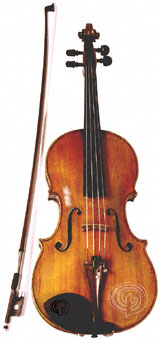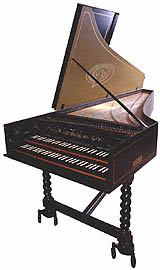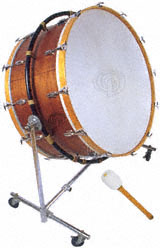
The four major instruments in the string family, the violin, the viola, the cello and the double bass, are built the same way. The instruments are made of many pieces of wood which are glued – never nailed – together. The body of the instrument is hollow, thus becoming a resonating box for the sound. Four strings (sometimes five on the double-bass) made of animal gut, nylon, or steel are wrapped around pegs at one end of the instrument and attached to a tailpiece at the other. They are stretched tightly across a bridge to produce their assigned pitches.
The viola is the alto voice in the string family. Like the violin, it is held under the chin, resting on the shoulder. Unlike the violin, the viola is slightly larger and is tuned five notes lower. It has a darker and warmer tone quality than the violin, but is not as brilliant.

The three branches of the woodwind family have different sources of sound. Vibrations begin when air is blown across the top of an instrument, across a single reed, or across two reeds. Reeds are small pieces of cane. A single reed is clamped to a mouthpiece at the top of the instrument and vibrates against the mouthpiece when air is blown between the reed and the mouthpiece. Two reeds tied together are commonly known as a double reed. This double reed fits into a tube at the top of the instrument and vibrates when air is forced between the two reeds.Originally made of wood, the flute is now made from silver or gold and is about 2 feet in length. It looks like a narrow tube with a row of holes covered by keys along one side. The player blows air across the small hole in the mouthpiece to produce a sound that can be either soft and mellow or high and piercing.

Keyboard instruments are often classified as percussion instruments because they play a rhythmic role in some music. However, most keyboard instruments are not true members of the percussion family because their sound is not produced by the vibration of a membrane or solid material.
The harpsichord is an early relative of the piano. Although it looks like a piano, it sounds much different. Small hooks called quills pluck the strings when the player’s hand presses a key on the keyboard.

With a name that means, “the hitting of one body against another,” instruments in the percussion family are played by being struck, shaken, or scraped. In the orchestra, the percussion section provides a variety of rhythms, textures and tone colors. Percussion instruments are classified as tuned or untuned. Tuned instruments play specific pitches or notes, just like the woodwind, brass and string instruments. Untuned instruments produce a sound with an indefinite pitch, like the sound of a hand knocking on a door. The percussion instruments are an international family, with ancestors from the Middle East, Asia, Africa, the Americas and Europe representing musical styles from many different cultures.
The composer Mozart added the deep, booming, untuned sound of the bass drum to the orchestra in 1782. Constructed like a snare drum, but without snares, the bass drum is much larger and is played on its side, so that either head may be struck. The beater or mallet for a bass drum is large with a soft material such as sheep’s wool covering the end.

Brass Family instruments produce their unique sound by the player buzzing his/her lips while blowing air through a cup- or funnel-shaped mouthpiece. To produce higher or lower pitches, the player adjusts the opening between his/her lips. The mouthpiece connects to a length of brass tubing ending in a bell. The shorter the tubing length, the smaller the instrument, and the higher the sound; and the longer the tubing length, the larger the instrument, and the lower the sound. The brass family can trace its ancestry back to herald trumpets, hunting horns, and military bugles. The main instruments of the brass family include the trumpet, horn, trombone, and tuba.
The mouthpiece of the trombone is larger than that of a trumpet, and gives the instrument a more mellow sound. Instead of valves, the trombone has a slide which changes the length of its approximately 9 feet of tubing to reach different pitches.
